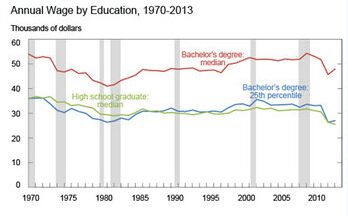一张图表告诉你为什么大学不适合所有人
|
爱思英语编者按:与普通的高中毕业生相比,底层四分之一拥有大学学历的工薪阶层所得薪酬大体相当,而且40年来这种情况没有发生真正的改变。
If you listen to the experts, they’ll tell you that, despite the rising cost of a degree, college still pays off. And the statistics bear this argument out. A college graduate will on average make $1 million more than a worker with just a high school degree over the course of his lifetime, making even a six-figure upfront investment well worth it in the end. Yet anecdotal evidence abounds of students who either flunked out of college or graduated with large debt loads and are still unable to land jobs that will make the investment in a degree pay off. How do we reconcile the statistics with these stories? This chart from the Federal Reserve Bank of New York shows that we can miss a lot when looking at just the average experience: The bottom quarter of earners with a college degree don’t make more money than the average high school graduate. And this hasn’t really changed much in 40 years. In fact, this graphic shows that a college degree has become more valuable even for the bottom quarter of earners, likely as a result of the evaporation of high-paying blue collar jobs, like those in the manufacturing industries. Of course, over the past 40 years, the cost of a degree has increased 12-fold, while a degree holder isn’t making more money at all, when accounting for inflation. So, it’s quite likely that, given the huge upfront investment for a college degree, many more workers today would have been better off not going to college at all. There are a few caveats that should be mentioned, however. First, we don’t know for sure how much money this bottom quarter of degree-holding earners would have made without their college education. Furthermore, much of this could boil down to career choice: there are many jobs that require a degree but don’t pay very well. If someone earns a degree for reasons beyond making more money, it could be that the upfront investment is worthwhile regardless. That being said, the above graph is certainly evidence that both the public and private sector need to make serious changes to provide higher education more efficiently. Unfortunately, this bit of information isn’t really helpful for the millions of Americans who need to decide how and where to send their kids to college. There is a well-established principle in behavioral economics that people systematically overestimate their abilities in general, and we can see this in the exponential increase in college costs. Up to 25% of college grads would probably be better off not pursuing a degree, yet nobody actually thinks they’re going to be the ones for whom the investment doesn’t pay off. Further compounding the problem is the fact that students usually don’t have a great idea of how they are going to fare in college, or what sort of degree or career they will pursue until after they’ve already made the decision to attend. One could argue that all this uncertainty is evidence that we should be investing more in public support of higher education. There’s plenty of evidence that there are what economists call “spillover effects” from students educating themselves, that society as a whole benefits from higher education. So there is justification for paying for higher education with tax dollars. And since students don’t know ahead of time what degree they will personally benefit from, it’s possible that students will just begin to forego college altogether, hurting society in general. There’s evidence that this is beginning to happen. In the meantime, students who are unsure of what they want to study or do are probably best advised to be very cost-conscious when choosing a college, and to be unafraid to wait until they are sure how they will use their degree before they start to pursue one.(FORTUNE CHINA) 专家们说,虽然攻读学位的费用不断增加,但是就读大学依然有所回报。 有统计资料证明了这一观点。与只有高中学历的工人相比,大学毕业生一生平均多收入100万美元,最终使高达六位数的前期投资得以回报。但是,中途退学或大学毕业时债台高筑、无法使学位投资有所回报的学生案例比比旨是。 我们如何使统计资料和具体案例保持一致呢?纽约联邦储备银行(Federal Reserve Bank of New York)提供的图表说明,如果我们只着眼于平均情况,就会错失很多信息: 与普通的高中毕业生相比,底层四分之一拥有大学学历的工薪阶层所得薪酬大体相当,而且40年来这种情况没有发生真正的改变。事实上,这个图表说明,或许由于高薪蓝领工作(如制造业工作)的消失,大学学位对底层四分之一的工薪阶层来说更加重要。当然,过去40年来攻读学位的费用增长了12倍,而把通货膨胀因素考虑在内后,大学毕业生的薪酬并没有出现增加。 因此,考虑到前期对大学学位的巨额投资,如果不就读大学,更多人的经济状况或许会更好。但是笔者在此提出几点注意事项。首先,我们无法给出如果不就读大学,底层四分之一的大学毕业生确切的工资数额。此外,这个问题可以归结为职业选择:许多工作有学历要求,但是提供的薪酬并不丰厚。如果有人出于赚钱以外的其他原因攻读学位,那么前期投资仍然是值得的。 尽管如此,以上图表成为公私部门需要做出重大调整,从而更有效地提供高等教育的有力证据。遗憾的是,对数百万美国家长来说,当他们需要决定如何让孩子就读大学,以及选择哪所大学就读时,这条信息的参考作用极为有限。 行为经济学中有一条固定原则,即人们经常高估自身的能力,而且我们可以从成倍增加的大学费用中看出这一点。高达25%的大学毕业生不读大学也有可能改善自身经济状况,但事实上,所有人都认为大学投资能够带来更高回报。 此外,在做出就读大学的决定之前,学生们通常并不清楚他们在大学中会有什么样的进展,他们会攻读哪种学位或从事哪种职业。这使情况变得更加复杂。 有人指出,所有这些不确定性成为我们加大投资,以获得公众对高等教育支持的证据。有大量证据表明,自学学生产生经济学家所谓的“溢出效应”,而且高等教育使整个社会受益。因此,使用纳税资金为高等教育买单是合理的。由于学生事先不清楚自己将从哪种学位受益,学生可能完全放弃学业,使整个社会受损。有证据表明,这种情况正在发生。 与此同时,给不确定学习或从事哪个行业的学生的最佳建议,是在选择大学时应该有成本意识,在开始攻读学位和确信如何运用学位之前,不要害怕等待。(财富中文网) |









